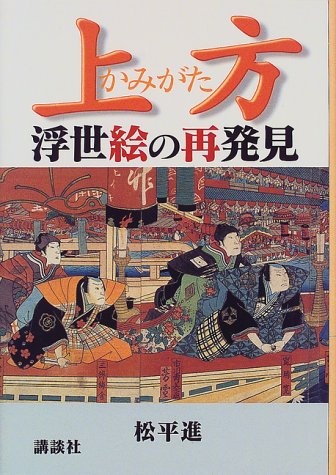7 0 0 0 OA ひいき連中について ―道頓堀一七八九~一八二九―
- 著者
- 松平 進
- 出版者
- 日本近世文学会
- 雑誌
- 近世文藝 (ISSN:03873412)
- 巻号頁・発行日
- vol.30, pp.70-80, 1979 (Released:2017-04-28)
1 0 0 0 OA 新出のN氏所蔵上方絵について
- 著者
- 松平 進
- 出版者
- 甲南女子大学
- 雑誌
- 甲南女子大学研究紀要 = Konan Women's University researches (ISSN:03864405)
- 巻号頁・発行日
- no.創立30周年記念[31], pp.57-83, 1995-03-10
1 0 0 0 IR 新出のN氏所蔵上方絵について
- 著者
- 松平 進
- 出版者
- 甲南女子大学
- 雑誌
- 甲南女子大学研究紀要 (ISSN:03864405)
- 巻号頁・発行日
- no.1995, pp.492-466, 1995-03-05
1 0 0 0 OA 大英博物館新収上方役者絵帖について
- 著者
- 松平 進
- 出版者
- 甲南女子大学
- 雑誌
- 甲南女子大学研究紀要 = Konan Women's University researches (ISSN:03864405)
- 巻号頁・発行日
- no.30, pp.23-44, 1994-03-18
1 0 0 0 IR 公開講演 上方役者の特色 ―ひいきとのかかわり―
- 著者
- 松平 進
- 出版者
- 国文学研究資料館
- 雑誌
- 国際日本文学研究集会会議録 = PROCEEDINGS OF INTERNATIONAL CONFERENCE ON JAPANESE LITERATURE (ISSN:03877280)
- 巻号頁・発行日
- no.19, pp.171-182, 1996-10-01
Kamigata actor print seem to have been produced with a strong connection to hiiki-theatre supporters or fans. Three cities (Osaka, Kyoto and Edo) had many fans and fan clubs, but especially Osaka fans were very active. Among them, Teuchi renchū (clapping clubs) were top groups. Every winter, in kaomise performance (face showing performance), these clubs performed a ceremony of clapping to introduce actors to the public.One can see hiiki together with actor in Osaka theatre prints. For example, Seki Sanjūrō II came to Osaka, Kado theatre in 1826 from Edo. The artist Ashiyuki produced Sanjūrō's greeting from stage surrounded by many Sakura-ren hiiki in Sakura-ren uniforms. The space of the print is dominated not by Sanjūrō but by hiiki. I wonder if this kind of print could sell well as an actor print ?Not only ō-shibai but also chū-shibai had the custom of teuchi. There is a print in the same style of Ichikawa Morinosuke surrounded many hiiki in uniform. From the crest of hiiki-ren one cannot tell the name of the ren. In the print, there are two hiiki facing us. The faces are clearly drawn as portraits, but are not actors. I guess hiiki put their portrait in the actor print. There is a hiiki Rojū's print in the uniform of Sasase-ren. He was well known as the Sasase-ren's best clapper. Rojū must have subsidized this publication. Seeing this print helps us better understand the previous example.Let's examine the san(讃)-kyōka or kyōku (comic poems) found in actor prints. The composers of san can be divided into four types. (1) Actor himself composed the san. This is the most common case. (2) Hiiki composed the poem. Sometimes they are annonymous. but we can see the names such as Akatsuki Kanenari, Harunoya, Baikō, Toran, Shiinomoto-an and famous hiiki. (3) Artist composed the poem. Mainly the artist who drew the actor portrait composed the poem as well. But sometimes another artist offered the poem. (4) Publisher composed the poem. Naturally publisher can be a supporter of theatres or actors. Tenmaya Kihei and Tokuraya Shinbei often composed poems for prints. Let's examine carefully the artist Yoshikuni and his group. Members are mainly Yoshikuni's pupils. The names of them have -kuni at the end such as Kishikuni, Hashikuni. Chikakuni etc. Or Yoshi- at the top such as Yoshiyuki, Yoshinao. Most of members were not productive. Though I have seen about 200 prints by Yoshikuni. I only have seen less than 10 prints each of 16 out of 19 members of this group. This group produced many chū-shibai actor prints, so they must have been supporters of chūshibai. There are three materials published in 1815 other than actor prints concerning hiiki and artists. The single sheet "HIIKI" compares the list of Arashi Kichisaburō hiiki and Nakamura Utaemon hiiki. At the bottom of the sheet you can find name list of 44 Naniwa Nigao Eshi (Osaka actor portrait artists)."Hiiki no Hanamichi" is a hyōbanki (critique) of Utaemon's supporters. Among hiiki you find three artists Ashikuni. Shunkō and Shunyō. According to the critique, none of them were professional actor print artists. I guess they were rich merchants and dilettante theatre goers and amateur artist."Shikan Setsuyō Hyakke Tsū" is a kind of introductory encyclopedia of Utaemon's fan club. There is name list of hiiki in which you can find Shunyō, Shunkō and Utakuni. They were hiiki as well as artists.Kamigata actor prints were produced through a strong connection with hiiki. Publisher and artist were often hiiki. Before Hasegawa Sadanobu and Ryūsai Shigeharu, there were no professional artists. But it does not mean artistic inferiority. Many kamigata prints of this period are excecllent.
1 0 0 0 上方のひいき連中と役者絵 (役者絵特集号-3-)
- 著者
- 松平 進
- 出版者
- 国際浮世絵学会
- 雑誌
- 浮世絵芸術 (ISSN:00415979)
- 巻号頁・発行日
- no.114, pp.p10-11, 1995-01
1 0 0 0 IR 大英博物館新収上方役者絵帖について
- 著者
- 松平 進
- 出版者
- 甲南女子大学
- 雑誌
- 甲南女子大学研究紀要 = Konan Women's University researches (ISSN:03864405)
- 巻号頁・発行日
- no.30, pp.23-44, 1994-03-18
1 0 0 0 ひいき連中について:―道頓堀一七八九~一八二九―
- 著者
- 松平 進
- 出版者
- 日本近世文学会
- 雑誌
- 近世文藝 (ISSN:03873412)
- 巻号頁・発行日
- vol.30, pp.70-80, 1979

